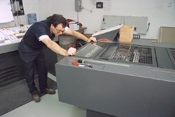
|
|
What is takt time?

Takt time comes from the German word Taktzeit, which roughly translates into "cycle time" in English. It was originally developed to explain the beat or rhythm of music during a performance.More recently, it is an important element in Lean Manufacturing practices.Most simply explained, it is the longest amount of time which can be spent on each unit of a product while still meeting the level of demand. It is particularly useful for making production lines more effectively and flawlessly.
|
|
Virtually every task in a manufacturing environment is calculated by takt time. It is used for everything from part casting, drilling, and task preparation to control tasks such as testing and adjusting machinery and parts. Even administration services like answering inquiries and call center operations can be calculated using takt time.It is most common in production lines that move a product along multiples station lines that perform tasks.
Once implemented, a takt system offers several benefits:
- It provides an essential rhythm for the factory, thus stabilizing production at a consistent rate.
- Ideally all tasks become balanced with the help of work cell designers.
- It allows a team to be more aware of output rates and potential challenges with immediate feedback on performance.
For certain machines or processes, takt time may mean slowing down so there is no queue time for other machines and all processes can run at a more consistent pace. As product moves along a line, bottlenecks, or stations that need more time, are easily identified. In addition, stations that are not reliable, or operate with many problems can also be easily identified and corrected.
Takt time leaves a very specific amount of time in which to perform each piece of work. Therefore non value-adding tasks (machine set up, gathering tools, transporting materials) are reduced or altogether deleted from the course of the production line. Workers and machines perform similarly set tasks so they don't have to adapt to new processes every day."Lost" products are reduced as all the products become stuck in the line and cannot leave it.
There are also some downsides to using takt time:
- If customer demand rises so much that takt time has to come down, quite a few tasks have to bereorganized to take even less or they have to be split up between two stations (which means another station with new workers adapting to the new set up has to be put into the line.
- One station breaking down will make a whole line come to a grinding halt unless there are buffer capacities for preceding stations to get rid of their products and following stations to feed from. Many manufacturers use a built-in buffer of three to five percent downtime to allow needed adjustments or recovery from failures.
- Shortened takt time can put considerable stress workers and machines, increasing breakdowns and lowering motivation to the point of absenteeism.
- There is a decrease in the flexibility of the system as a whole.
Calculating takt time is an extremely simple process. It is the total time available to produce a batch of products, divided by the total number of unites that must be produced to meet the deadline.In reality, it can become slightly more complicated to configure as there are variables such as staffing levels, shifts, and staggered break times to consider as well. Most companies that use takt time also build in a certain amount of time for problems with machines breaking or accidents.
Calculating Takt time is, in its most basic form, an extremely simple process. It is merely the total time available to produce a batch of products divided by the total number of units which must be produced to meet the deadline. In practice the calculation may be slightly more complicated as it may need to take account of varying staffing levels if there are shifts or staggered break times. The units used for Takt time will vary from site to site depending on whether it is a simple product with an hourly target or larger products such as automobiles that may be expressed in a timeframe of days or weeks.
Privacy Policy, Terms of Use